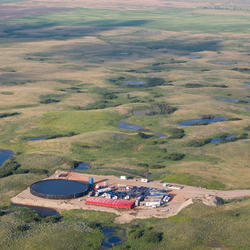Municipal and Industrial Wastewaters
Municipal and Industrial Wastewaters
Filter Total Items: 25
A Field Method to Quantify Chlorinated Solvent Diffusion, Sorption, Abiotic and Biotic Degradation in Low-Permeability Zones
Strategic Environmental Research and Development Program project ER-2533 In chlorinated-solvent-contaminated fractured-sedimentary-rock aquifers, low-permeability (low-K) strata typically act as long-term or secondary sources of contamination to mobile groundwater in the high-permeability fractures. The fate of dissolved trichloroethene (TCE) in the low-K matrix is controlled by abiotic...
Drinking Water and Wastewater Infrastructure Science Team
The team studies toxicants and pathogens in water resources from their sources, through watersheds, aquifers, and infrastructure to human and wildlife exposures. That information is used to develop decision tools that protect human and wildlife health.
Nationwide Occurrence
A National-scale approach is used to examine and analyze per- and polyfluoroalkyl substances (PFAS) prevalence and magnitude in watersheds and aquifers. As an initial step to fill known science gaps in the understanding of human and wildlife exposure, the team will provide a snapshot of PFAS in drinking water paired with bioaccumulation in fish and wildlife near known or suspected sources of...
Energy Integrated Science Team
The Energy Lifecycle Integrated Science Team focuses on the potential for contaminant exposures in the environment that might originate from energy resource activities including, extraction, production, transportation, storage, extraction, waste management and restoration. Perceived health risks to humans and other organisms will be distinguished from actual risks, if any. If actual risks are...
Refined Model Provides a Screening Tool to Understand Exposure to Contaminants from Incidental Wastewater Reuse
Refinement of the existing national-scale “de facto reuse incidence in our nation’s consumable supply” (DRINCS) model, complemented by field measurements, provides a screening tool to understand human and wildlife exposure to toxicants and pathogens associated with the incidental reuse of treated wastewater in the Shenandoah River watershed. The model results can be accessed in a companion web...
Ongoing Research to Characterize the Complexity of Chemical Mixtures in Water Resources—Urban Stormwater
A multiagency reconnaissance study of chemicals in urban stormwater, sampled from pipes or ditches during 50 runoff events at 21 sites in 17 states across the United States, demonstrated that stormwater runoff contains complex mixtures of chemicals including polycyclic aromatic hydrocarbons, pesticides, and pharmaceuticals that are indicative of multiple sources in the watershed.
Can There be Unintended Benefits when Wastewater Treatment Infrastructure is Upgraded?
Science from the U.S. Geological Survey (USGS) and other entities has shown that a mixture of natural and synthetic estrogens and other similar chemicals are discharged from wastewater treatment plants (WWTPs) to streams and rivers.
Are Spills Associated with Deep Well Injection of Wastewater from Oil and Gas Operations a Health Hazard?
Our specialized teams of hydrologists, chemists, biologists, and geologists worked together in the New River Gorge National River watershed to answer this question. Wastewater generated in association with oil and gas operations at this site is managed by injection in deep wells designed to safely dispose and contain contaminants in deep geologic formations. Contaminants associated with oil and...
Exploring the Suitability of a Modeling Approach to Estimate Contaminant Occurrence in Drinking Water Sources
Scientists explored the suitability of the DeFacto Reuse in our Nation's Consumable Supply (DRINCS) model to estimate the likelihood of contaminants from upstream wastewater discharges to enter drinking water facility intakes.
Selected Pharmaceuticals Not Likely to Persist in Wild Fish: Results of Uptake and Elimination Testing
Laboratory study shows that both uptake and elimination of selected pharmaceuticals within bluegill tissues is rapid indicating that persistence in bluegills in the environment is likely to be low except in those fish that reside downstream from a consistent, substantial, contaminant source.
Commonly Used Chemicals Transported to Agricultural Field through Municipal Biosolids Application
Commonly used chemicals (including fragrances, detergents, fire retardants, plasticizers, and antibacterials) transferred to wastewater treatment plants were detected in municipal wastewater biosolids applied to agricultural field plots and subsequently detected in the runoff transported from the plots during precipitation events.
Two Scientists Receive Early Career Excellence in Leadership Award
The U.S. Geological Survey (USGS) 2016 Early Career Excellence in Leadership Award was given to Dr. Denise M. Akob and Dr. Karl B. Haase. Drs. Akob and Haase have demonstrated outstanding leadership through their scientific accomplishments and service to the USGS.













